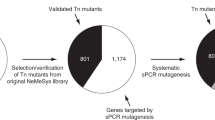Summary
Mutants of S. marcescens HY have been isolated which produce between five and one hundred times more exocellular nuclease than does the parental strain. These nuclease-superactive (nuc su) mutants are highly pleiotropic: they produce more exocellular marcescin A and lipase than the wild-type and their ability to inactivate penicillin G is increased. Furthermore, all nuclease-superactive mutants if lysogenic for the heteroimmune phages Kappa and/or y show spontaneous induction rates for both prophages 10 to 200 fold greater than the corresponding wild-type. Nuc su mutants of independent origin synthesize nuclease and marcescin A in approximately proportional amounts although the corresponding structural genes do not seem to be part of a single operon because some bacteriocin-superactive mutants were isolated which showed an increase of the synthesis of marcescin A only. Nuclease-defective (nuc) mutants are all of the non-pleiotropic type. Three hypotheses to explain the effects of the nuc su mutation at the molecular level are discussed and some evidence in support of one of these hypotheses (gene-dosage effect) is presented in an accompanying paper (Timmis and Winkler, 1973).
Similar content being viewed by others
References
Endo, H., Kamiya, T., Ishizawa, M.: λ-phage induction by colicin E2. Biochem. biophys. Res. Commun. 11, 477–482 (1963)
Fleming, P. C., Goldner, M., Glass, D. G.: Observations on the nature, distribution, and significance of cephalosporinase. Lancet 1963I, 1399–1401
Grodzicker, T., Arditti, R., Eisen, H.: Establishment of repression by lambdoid phage in catabolite activator protein and adenylate cyclase mutants of E. coli. Proc. nat. Acad. Sci. (Wash.) 69, 366–370 (1972)
Harword, J., Smith, D. H.: Catabolite repression of chloramphenicol acetyl transferase synthesis in E. coli K 12. Biochem. biophys. Res. Commun. 42, 57–62 (1971)
Hong, J., Smith, G. R., Ames, B. N.: Adenosine 3′:5′-cyclic monophosphate concentration in the bacterial host regulates the viral decision between lysogeny and lysis. Proc. nat. Acad. Sci. (Wash.) 68, 2258–2262 (1971)
Kirby, E. P., Ruff, W. L., Goldthwait, D. A.: Cell division and prophage induction in Escherichia coli: Effects of pantoyl lactone and various furan derivates. J. Bact. 111, 447–453 (1972)
Kontomichalou, P., Mitani, M., Clowes, R. C.: Circular R-factor molecules controlling penicillinase synthesis, replicating in Escherichia coli under either relaxed or stringent control. J. Bact. 104, 34–44 (1970)
Lawrence, R. C., Fryer, T. F., Reiter, B.: Rapid method for the quantitative estimation of microbial lipases. Nature (Lond.) 213, 1264–1265 (1968)
Levinthal, M., Simoni, R. D.: Genetic analysis of carbohydrate transport-deficient mutants of Salmonella typhimurium. J. Bact. 97, 250–255 (1969)
Nakazawa, A., Tamada, T.: Involvement of cyclic 3′, 5′-adenosine monophosphate in replication of colicinogenic factor E1 DNA. Biochem. biophys. Res. Commun. 49, 977–983 (1972a)
Nakazawa, A., Tamada, T.: Stimulation of colicin E1 synthesis by cAMP in mitomycin C-induced E. coli. Biochem. biophys. Res. Commun. 46, 1004–1010 (1972b)
Nashif, S. A., Nelson, F. E.: The extracellular lipases of some gram-negative non-sporeforming rod-shaped bacteria. J. dairy Sci. 36, 698–706 (1953)
Nordström, K., Ingram, L. C., Lundbäck, A.: Mutations in R-factors of Escherichia coli causing an increased number of R-factor copies per chromosome. J. Bact. 110, 562–569 (1972)
Perlman, R. L., Pastan, I.: Pleiotropic deficiency of carbohydrate utilization in an adenyl cyclase deficient mutant of Escherichia coli. Biochem. biophys. Res. Commun. 37, 151–157 (1969)
Prinsloo, H. E.: Bacteriocins and phages produced by Serratia marcescens. J. gen. Microbiol. 45, 205–212 (1966)
Steiger, H.: Repressor-defekte Mutanten, virulente Mutanten und Adsorptionsresistenz lysogener Zellen beim Phagen Kappa von Serratia. Molec. gen. Genet. 103, 21–28 (1968)
Steiger, H.: Genetic studies with two prophages naturally resident in Serratia marcescens HY. Molec. gen. Genet. 122, 345–352 (1973)
Timmis, K., Winkler, U.: Gene dosage studies with pleiotropic mutants of Serratia marcescens superactive in the synthesis of marcescin A and certain other exocellular proteins. Molec. gen. Genet. 124, 207–217 (1973)
Winkler, U.: Extrazelluläre Nuklease-, Protease-und Bacteriocin-Aktivität beim Wildtyp und Mutanten von Serratia marcescens HY. Abl. Bakt., I. Abt. Orig. 205, 62–63 (1967)
Winkler, U.: Mutants of Serratia marcescens defective or superactive in the release of a nuclease, p. 187–201. In: Molecular genetics, H. G. Wittmann and H. Schuster, eds. Berlin-Heidelberg-New York: Springer 1968
Author information
Authors and Affiliations
Additional information
Communicated by G. Bertani
Rights and permissions
About this article
Cite this article
Winkler, U., Timmis, K. Pleiotropic mutations in Serratia marcescens which increase the synthesis of certain exocellular proteins and the rate of spontaneous prophage induction. Molec. Gen. Genet. 124, 197–206 (1973). https://doi.org/10.1007/BF00293091
Received:
Issue Date:
DOI: https://doi.org/10.1007/BF00293091




